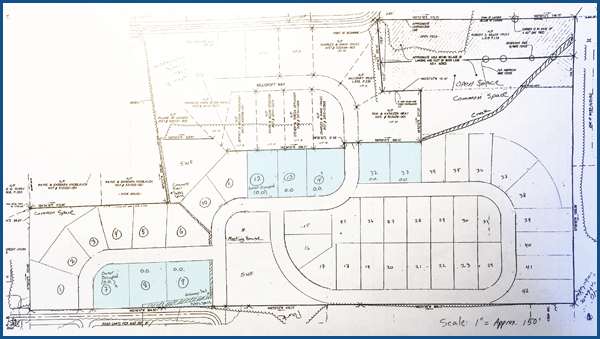- By Dan Veaner
- News
 Print
Print 
Steven, David, and Beverly Beer were hoping that the third time would be the charm Monday, when they informally presented a new proposal for a development on remaining Miller property south of Millcroft Road in the Village of Lansing. Rather than asking for a PDA (Planned Development Area, a kind of zoning that makes special rules for a particular project) that they wanted for their previous proposals, their new proposal proposes 84 units allowed for the property under the current zoning. In this preliminary meeting they asked the Planning Board to consider allowing them to use a 'clustering' provision of the zoning ordinance that would allow for more intimate neighborhoods while guaranteeing that 20% of the property would remain 'forever wild' in addition to the 6% of the developed portion of the property they plan to develop as common space for the residents.
"There is the opportunity for the total of 84 units to be developed here in a straightforward, plain vanilla subdivision by right," said the Beers' attorney Randall Marcus. "The option exists for the developer to come in and carve up the property into those lots. That's certainly something that could be done, however the Beers would like to take advantage of the clustering option for a variety of reasons. It's our perspective that those reasons all redound to the benefit of the village."
Last year Beer Properties proposed a unique project for a PDA that would include 97 rental units in 84 buildings, most of them small cottages, to a property south of Millcroft Way, grouped in pocket neighborhoods around shared green space. After nearly eight months of deliberation the Planning Board said that there wasn't a compelling benefit to the Village that couldn't be achieved by a project abiding by existing zoning. In February the Beers came with another proposal for a PDA that addressed many of the Board's concerns, but that plan was also rejected. At Monday's meeting the Beers made it clear that they are abandoning their request for a PDA.
"I'd like to highlight the fact that that was a PDA," Marcus said. "This is not a PDA. This is a straightforward subdivision with which the Beers would like to take advantage of the cluster subdivision provisions. I think it bears emphasis that in the case of a PDA, and why that didn't proceed -- the PDA required both the Planning Board's recommendation and the Trustees' approval, which could only be granted in each case, based upon the PDA satisfying a long list of criteria, that results in the development providing something more to the Village than could have been provided under the Village's zoning. That's history."
 This sketch shows 42 lots. The eight colored in blue would be sold to individual owners who want to build their own house. The remaining lots would be rental units.
This sketch shows 42 lots. The eight colored in blue would be sold to individual owners who want to build their own house. The remaining lots would be rental units.The new plan calls for 42 lots holding 84 units. The eight lots that border current homes would be sold to people that want to build owner-occupied houses themselves. The remaining would be rental units owned and maintained by Beer Properties.
If the Planning Board approves the clustering plan it amounts to a trade. The Village gets untouched, largely wooded open space, which is a Village goal. The Beers get to build homes closer together.
"Clustering does not change the number of buildings that can be built," said the Beers' attorney Randall Marcus. "There is no increase, there's no decrease. there's simply no change. Clustering has no impact whatsoever on the total allowable number of units. What clustering does is a trade-off. It allows the Village to end up with open space up to 20% of the developable area of the subdivision, and that's in addition to whatever common area might be built into the subdivision. In exchange for setting aside that 'forever wild' open space it would be compensated for by allowing somewhat smaller lots. By that I mean somewhat less acreage, somewhat shorter road frontages, and the possibility of somewhat diminished side yard setbacks."
Marcus noted that the proposed reduction in the lots is not significant. The lots would be 20,000 square feet vs. the zoning requirement (without clustering) of 25,000 square feet for a duplex lot. The smaller lots would have 100 feet of road frontage, as opposed to 125 feet called for in the zoning. Side yard setbacks would be reduced from 20 feet to 15 feet.
The Planning Board acknowledged the project falls within allowable building within the existing zoning, and that their option is whether or not to approve the cluster spacing of lots. They asked a few questions, and there was some discussion of how Lansing Trails 3 would connect to the Beer project.
Because of the eight month consideration of the previous projects that were quite costly for the Beers because of plans, engineering, and attorney's fees, Planning Board Chair Lisa Schleelein said she doesn't want the developers to spend a lot of money before they have a chance to discuss the new project in more detail with the Planning Board. Next steps include a second developer's conference at which a more formal version of the plan may be presented. Engineering and a preliminary subdivision plot would then be submitted. A public hearing will be required before the Board votes on whether or not they will approve the clustering plan.
v15i19



